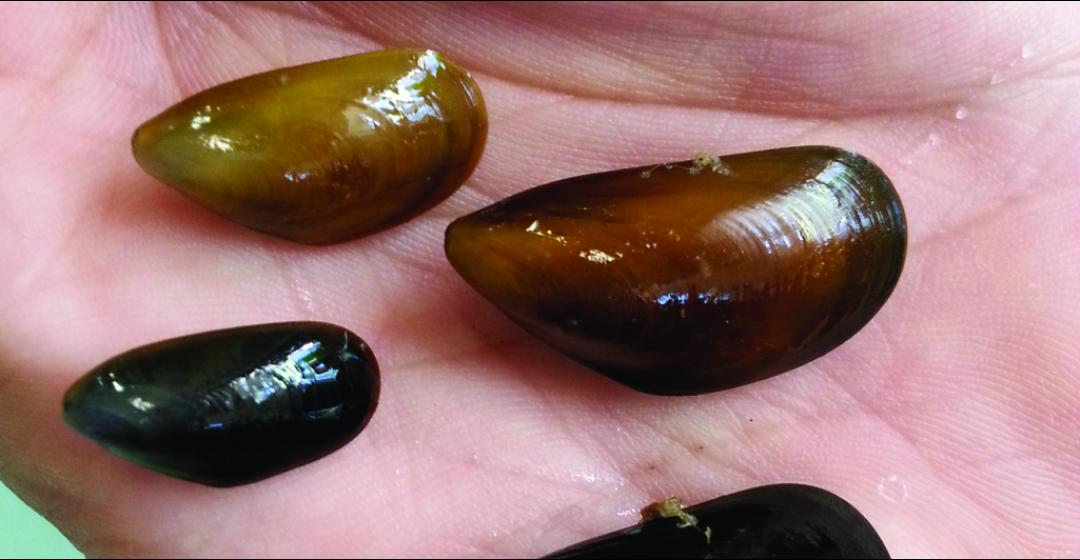If all goes well, local biologists will soon be growing gold in local waters. Scientists with the Martha’s Vineyard Shellfish Group and the Marine Biological Laboratory (MBL) have been breeding golden mussels, a unique-hued version of the common mussel that they hope will boost the Island’s nascent farmed mussel industry.
Wild mussels come in lots of colors, said shellfish group biologist Emma Green-Beach, who is leading the project. “You never notice the wide array, the shades of blues and browns they come in.” Some are light brown with dark stripes, others light with dark stripes, and some are dark blue, almost black.
“What we really, really want is a mussel that’s quite golden, more golden than brown, all the way through,” she said. Working with MBL biologist Scott Lindell, she has been gathering mussels in the wild to breed: two golden mussels that breed will produce golden mussel seed.
The end goal is to produce lots of seed to provide to local mussel farmers, who could then use the unique color as a marketing tool. The mussels won’t taste any different, but when the golden mussels go to market, said Green-Beach, they will be “easily identified as the local aquacultured mussels.” In other words, move over Vineyard Vines, there’s a new brand in town.
Today there is one mussel farm operating on the Vineyard. Stanley Larsen, the owner of Menemsha Fish Market, took over the farm in Vineyard Sound earlier this year. The farm was a pilot project created with help from the shellfish group, Lindell, and local and federal funding. The mussels that Larsen has been harvesting are the familiar range of colors, and have been a bit of a secret treat for those who know enough to ask for them.
“Everyone has been telling me they are the best mussels they have ever tasted,” said Larsen. Despite Menemsha Fish Market’s success this year, mussel farming on the Island faces challenges.
According to Lindell these include fouling by tunicates and other organisms. Farms also need to be tended regularly to insure the weight of the ropes is properly managed and the mussels don’t fall to the ocean floor, where other animals can eat them. Sea ducks have been known to target mussel farms for a feast.
But if all goes right, mussels fetch good prices. “I think it’s a great diversification opportunity for fishermen and people who are interested in working on the water,” said Lindell. “If you have a boat and you have the seafaring adventure in your blood, it’s a wonderful way to make a living.”
Larsen’s operation currently uses a “natural set,” collecting wild mussel seed from the surrounding waters. But wild mussels can be fickle spawners. According to Lindell, “mussel seed isn’t always available, or when it’s available it’s not in the kind of quantity and quality we would need to sustain mussel farms here.”
One goal of the golden mussel effort, therefore, is to make it worthwhile for aquaculturalists to use the more expensive, more consistent hatchery-raised seed. The distinctive color of the mussels would assure buyers that they are getting a locally raised product, for which, it is hoped, they would be willing to pay a higher price.
“It’s meant to make them look kind of special, kind of fun,” Green-Beach said. “Because the long-term vision is that the mussel industry could be so successful that it will need hatchery-raised seed.”
This summer some golden mussels did spawn, said Green-Beach, producing some “very golden” seed. Lindell put them in the water at Larsen’s farm, but it’s not clear yet how they’ve fared.
“There might be some unforeseen reason that golden mussels grow slower or their shells are thinner, or something that makes them less attractive,” Lindell said. “Probably by this time next fall we’ll have preliminary answers about whether it’s viable.”
If the answer is yes, look to see them turning up in their finest local gold on a menu near you.





